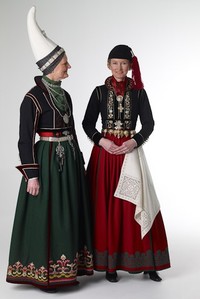Icelandic National Costumes Information
This website is published by the Icelandic National Costume Board and contains information and pictures of Icelandic national costumes. The board was established by the Minister of Education and Culture in the beginning of the year 2001 and its role is to conserve and pass on knowledge of the Icelandic traditional costumes and how they were made, as well as to provide advice about the costumes.

Paintings and manuscript illuminations have provided information about clothing in the 16th and 17th centuries while information from the 18th century is more extensive, including pictures and written accounts of the living conditions in Iceland and the way of life, as well as some fragments of clothing that have survived from the period
In these centuries the women´s dress was faldbúningur. It evolved and changed slightly during this time and had almost disappeared around 1850. At that time some Icelandic women dressed in a similar fashion as women in other countries. The traditional clothes of the period, peysuföt, had evolved from the faldbúningur, yet were simpler and less decorative. In the 20th century, peysuföt were still worn with some modifications. Upphlutur had always been part of the old faldbúningur as an undergarment and when it was warm, as working clothes.. At the beginning of the 20th century it became a separate costume.
When the faldbúningur ceased to be in use, in the middle of the 19th century, an Icelandic artist, Sigurður Guðmundsson, designed two new costumes, the skautbúningur and the kyrtill. He viewed these costumes as having a role in the movement for independence from Denmark.
Much less is known about the traditional men´s dress in Iceland than women´s dress and very few pieces of old men´s garments have survived. Based on these limited resources hypotheses have though been made on how men have dressed through the ages.
Children´s clothes were generally similar to adult clothing both for girls and boys, but at the beginning of the 20th century new costumes were designed for young girls.
Now both men and women use national costumes for celebration, most of them are newly made, based on old patterns and methods.


